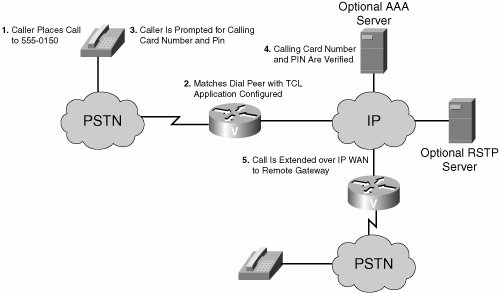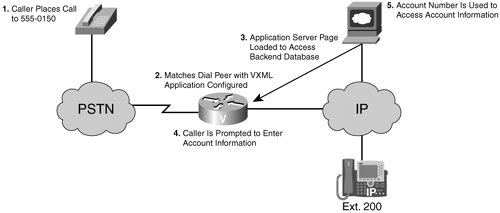Tcl IVR and VoiceXML Application Overview
Both Tcl IVR 2.0 and VoiceXML can support extremely complex applications. These complex applications are built by stringing together basic functions that fall into the following categories:
- Play audio prompts
- Collect user input in the form of DTMF tones
- Modify automatic number identification (ANI) or dialed number identification service (DNIS)
- Influence call routing
- Record call information
- Perform call admission control
Note
MGCP is not supported with Tcl or VoiceXML applications. To support applications, the gateway must have local control of the call.
The main difference between Tcl and VoiceXML is that the router executes a Tcl script, whereas a VoiceXML script is a client-server model. If the gateway associates a call with a VoiceXML application, the application loads the appropriate VoiceXML document that can call for the gateway to interact with various web applications. This document might play audio prompts and collect digits. You can load additional VoiceXML documents based on the caller input.
Both Tcl and VoiceXML servers can utilize external RADIUS authentication, authorization, and accounting (AAA) servers for authentication and billing and TFTP servers for storing of scripts or prompts.
Figure 15-1 shows the interaction between a caller and a typical Tcl application providing prepaid calling card service. The caller dials a toll-free access number. The Tcl script prompts the caller for his calling card number, his personal identification number (PIN), and the number he wants to reach. After the Tcl application authenticates the calling card number and PIN with the AAA server, it extends the call to the remote gateway. The remote gateway then completes the call to the destination.
Figure 15-1. Caller Interaction with a Tcl Application

Figure 15-2 shows the interaction between a caller and a VoiceXML auto attendant (AA) application. The application prompts the user for his account number and uses this to access the customer records. The web application can then prompt the caller through checking balances, transferring funds, or other self-help activities, or it can transfer the caller to an agent for personalized service.
Figure 15-2. Caller Interaction with a VoiceXML Application

Tcl IVR 2.0 added support for Real Time Streaming Protocol (RTSP) servers. This allows you to store the audio files, or prompts, on the external server and stream them directly to the caller. This increases both the size and number of prompts that you can use in an application. Prompts that you store in the flash of the gateway or on a TFTP server are loaded into the DRAM and are played from DRAM to the caller. The applications discussed in this chapter would not typically require an RTSP server.
If a custom application requires access to servers for prompts or data retrieval, you should consider survivability if the servers are not accessible. For example, Cisco Voice Portal (CVP) includes a call survivability script that attempts to transfer callers to an alternate location in the event of CVP application errors.
Developing Tcl or VoiceXML scripts requires knowledge of programming that is beyond the scope of this book. Cisco provides numerous Tcl applications, some of which are described in the next section. This chapter focuses on implementing Tcl scripts using these Cisco-provided applications for illustration purposes. The methods for implementing VoiceXML applications are similar from the gateway perspective.
Programming Resources
Cisco provides two excellent resources for developing your own Tcl or VoiceXML applications. The TCL IVR API Version 2.0 Programmer's Guide and Cisco VoiceXML Programmer's Guide are available from Cisco.com to registered users. Aspiring Tcl programmers should also review the wealth of information that is available at http://www.tcl.tk.
Cisco Systems also has a fee-based application development group that can develop an application to your specifications. In addition, a Cisco Technology Developer Program can provide support to third-party developers. Information on these programs is available from Cisco.com or from your Cisco account team.
Note
Only Tcl/VoiceXML applications that are developed through the Cisco Technology Developer Program are supported by the Cisco Technical Assistance Center (TAC).
Part I: Voice Gateways and Gatekeepers
Gateways and Gatekeepers
- Gateways and Gatekeepers
- The Role of Voice Gateways
- The Role of Voice Gatekeepers
- The Role of IP-to-IP Gateways
- Introduction to Voice Protocols
- Call Control Agents
- Deployment Scenarios
- Case Study: Introduction
- Chapter Review Questions
Part II: Gateways
Media Gateway Control Protocol
- Media Gateway Control Protocol
- Introduction to MGCP
- MGCP Operation
- Call Flow with MGCP
- Dial Plan Considerations
- Implementing MGCP Gateways
- Securing MGCP Gateways
- Troubleshooting Tools
- Case Study: Configuring an MGCP Gateway
- Review Questions
H.323
- H.323
- H.323 Specifications
- H.323 Network Components
- Call Flow
- H.323 Protocol Pros and Cons
- When to Use H.323
- Dial Plan Considerations
- Implementing H.323 Gateways
- Securing H.323 Gateways
- Troubleshooting Tools
- Case Study: Configuring an H.323 Gateway
- Review Questions
Session Initiation Protocol
- Session Initiation Protocol
- Description of SIP
- SIP Call Flow
- SIP Pros and Cons
- When to Use SIP
- Dial Plan Considerations
- Implementing SIP Gateways
- Securing SIP Gateways
- Allowing H.323 to SIP Connections
- Troubleshooting Tools
- Case Study: Configuring SIP Between a Gateway and CallManager 5.x
- Review Questions
Circuit Options
Connecting to the PSTN
- Connecting to the PSTN
- PSTN Circuit Selection Overview
- Analog Trunks
- Digital Trunks
- Case Study: Add an E1 R2 Connection to the Leeds Gateway
- Review Questions
Connecting to PBXs
- Connecting to PBXs
- Analog Trunks
- Digital Trunks
- Configuring Transparent Common Channel Signaling
- Case Study: Implementing a Cisco Voice Gateway at the Shanghai Office
- Review Questions
Connecting to an IP WAN
- Connecting to an IP WAN
- Applications for Connecting to an IP WAN
- Design Considerations
- Quality of Service
- Providing Fax and Modem Services
- Security
- Case Study: Using a T1 Link as a Tie Line
- Review Questions
Dial Plans
- Dial Plans
- Numbering Plans
- Overlapping Numbering Plans
- Building a Scalable Dial Plan
- Dial Peers
- Dial Peer Matching
- Case Study: Configuring PSTN Access
- Review Questions
Digit Manipulation
- Digit Manipulation
- Basic Digit Manipulation
- Number Expansion
- Voice Translation Rules and Profiles
- Manipulating Caller ID
- Order of Operation in Digit Manipulation
- Troubleshooting Digit Manipulation
- Case Study
- Review Questions
Influencing Path Selection
- Influencing Path Selection
- Hunt Groups
- Using Trunk Groups
- Tail-End Hop-Off
- Call Admission Control
- POTS-to-POTS Call Routing Considerations
- Case Study: Implementing Gateway-Controlled RSVP
- Review Questions
Configuring Class of Restrictions
- Configuring Class of Restrictions
- COR Overview
- COR Operation
- Implementing COR
- Assigning COR Lists with SRST
- Assigning COR Lists with Cisco CallManager Express
- Restricting Inbound Calls
- Case Study: Implementing COR for Miami
- Review Questions
SRST and MGCP Gateway Fallback
- SRST and MGCP Gateway Fallback
- SRST Overview
- Configuring SRST
- Dial Plan Considerations
- SRST Features
- SIP SRST
- Call Preservation
- Secure SRST
- MGCP Gateway Fallback
- Configuring MGCP Gateway Fallback
- Verifying and Troubleshooting SRST
- Verifying and Troubleshooting MGCP Gateway Fallback
- Case Study: Integrating SRST with an Analog Voice-Mail System
- Review Questions
DSP Resources
- DSP Resources
- Need for DSP Resources
- Determining the DSP Resources Required
- Configuring DSP Resources
- Transcoding for CallManager Express
- Case Study: Add DSP Resources to the Miami Gateway
- Review Questions
Using Tcl Scripts and VoiceXML
- Using Tcl Scripts and VoiceXML
- Tcl IVR and VoiceXML Application Overview
- Sample Applications
- Downloading Tcl Scripts from Cisco.com
- Configuring the Gateway to Use a Tcl Script
- Implementing the AA Tcl Script
- Creating Audio Files
- Restrictions and Caveats
- Case Study: Implementing ACD Application
- Review Questions
Part III: Gatekeepers
Deploying Gatekeepers
- Deploying Gatekeepers
- Gatekeeper Functionality
- Gatekeeper Signaling
- E.164 Number Resolution
- Call Admission Control
- Gatekeeper Deployment Models
- Gatekeepers with CallManager
- Security with Gatekeepers
- Review Questions
Gatekeeper Configuration
- Gatekeeper Configuration
- Configuring Basic Gatekeeper Functionality
- Multiple Gatekeeper Configurations
- Configuring Directory Gatekeepers
- Troubleshooting Gatekeepers
- CallManager and Gatekeepers
- Gatekeeper Redundancy
- Configuring Resource Availability Indicator
- Configuring Gatekeeper Security
- Case Study: Deploying Gatekeepers to Assist in Migration to VoIP
- Review Questions
Part IV: IP-to-IP Gateways
Cisco Multiservice IP-to-IP Gateway
- Cisco Multiservice IP-to-IP Gateway
- IP-to-IP Gateway Overview
- Cisco Multiservice IP-to-IP Gateway
- Basic Configuration
- IP-to-IP Gateway Features
- Case Study: Providing Enterprise VoIP Trunking to VoIP Service of the Service Provider
- Review Questions
Appendix A. Answers to Chapter-Ending Review Questions
Index
EAN: 2147483647
Pages: 218
